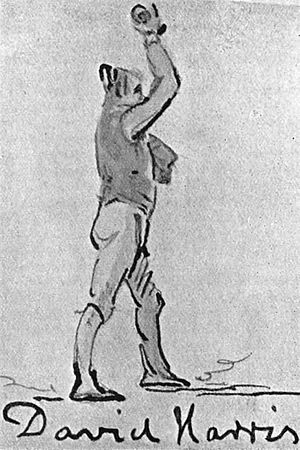David Harris (English cricketer) facts for kids
David Harris (1755 – 19 May 1803) was a famous English cricket player. He played first-class cricket from 1782 to 1798. Harris was known for his super-fast and accurate bowling. He was a right-arm underarm bowler and a left-handed batsman.
He played in 78 known first-class matches. He was mostly connected with Hampshire, especially when the Hambledon Club organized their teams. Besides Hampshire, Harris also played for other teams. These included Berkshire, Kent, Surrey, and Marylebone Cricket Club.
Contents
David Harris's Cricket Journey
David Harris was born in 1755 in Elvetham, Hampshire. His earliest known games were for a team called Odiham in 1782.
Early Matches and Key Moments
Harris' first recorded game for Hampshire was in July 1782. It was against Kent. Even though he wasn't known for his batting, Harris scored 27 runs in Hampshire's first turn. This was the highest score for his team.
In 1783, Harris played three times for Hampshire. He played twice against Kent and once against the All-England team. In these games, he took nine wickets. A wicket is when a bowler gets a batsman out.
In 1785, Harris played for Berkshire against Essex. Not many first-class matches happened that year.
Big Performances and Records
On 13 July 1786, Harris had a great game for Hampshire against Kent. He took four wickets in the first turn. Hampshire won that game by just one wicket. In this match, a player named Tom Sueter was given out for hitting the ball twice. This was the first time this type of dismissal was recorded!
Later that year, from 8 to 12 August, Harris played for the White Conduit Club against Kent. He took six wickets in the match, helping his team win by 164 runs. In that same game, Tom Walker and Tom Taylor became the first players known to score a century (100 runs) in the same turn. Walker almost scored two centuries in one match!
On 26–28 May 1788, Harris played at the new Lord's Old Ground. He took 10 wickets in that match. He got 4 wickets in the first turn and 6 in the second. However, his team still lost the game.
Later Career and Final Game
By the 1790s, Harris was a very well-known player. He often took many wickets. On 30–31 August 1790, he took ten wickets in a match. This helped Hampshire win by 10 wickets against All-England.
His best known performance was from 15–17 August 1792. Harris took 11 wickets in a match for Hampshire against Kent. He got eight wickets in the first turn alone! Hampshire won that game by 8 wickets.
Later in his career, Harris had health problems with his joints. This made it hard for him to play. His last match was from 13–15 August 1798. He played for All-England against Surrey. He took five wickets in the first turn. His team won the match by an innings and 1 run.
How David Harris Played
Many people who watched Harris play thought he was amazing. A famous writer named Frederic Reynolds described facing Harris. He said it felt like a duel! He was so nervous that he would close his eyes and just swing his bat.
Another person, John Nyren, said Harris was "the very best bowler." Nyren described Harris's unique bowling style in detail.
Harris's Bowling Style
Harris would start standing very straight, "like a soldier at drill." He would then raise the ball to his forehead before stepping forward. As he bowled, he would bring the ball from under his arm. He would "push it, as it were, from him." Nyren said the ball's speed was "extraordinary." He couldn't understand how Harris made it so fast.
Drawings from the 1790s show Harris in this special pose. The ball he bowled was very fast and accurate. It seemed to gain speed after hitting the ground. Nyren wrote that many batsmen got hurt on their hands. This was because they didn't wear gloves back then.
Like other famous bowlers of his time, Harris would practice his bowling. He even practiced in a barn during the winter months!
David Harris's Life Outside Cricket
Harris was born in Elvetham, but he moved to Crookham (now Crookham Village) as a child. He lived there for the rest of his life. He never got married and worked as a potter.
Nyren, who knew Harris well, said he was a "muscular, bony man." He was about five feet 9½ inches tall. Nyren also said Harris had a "remarkably kind and gentle expression" and an "honest face." He was known as a very honest and honorable person.
In his later years, Harris had a painful joint condition called gout. Sources say he would arrive at games using crutches. He would even sit on a chair between his turns to bowl. He couldn't play after 1798 because of his health. He passed away in 1803 in Crookham. He was buried nearby in Crondall.


